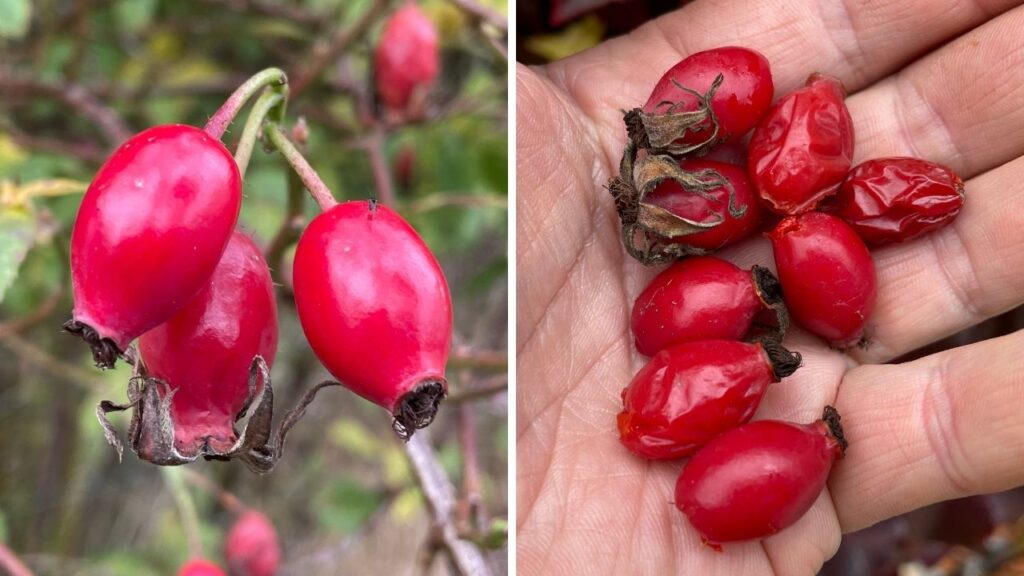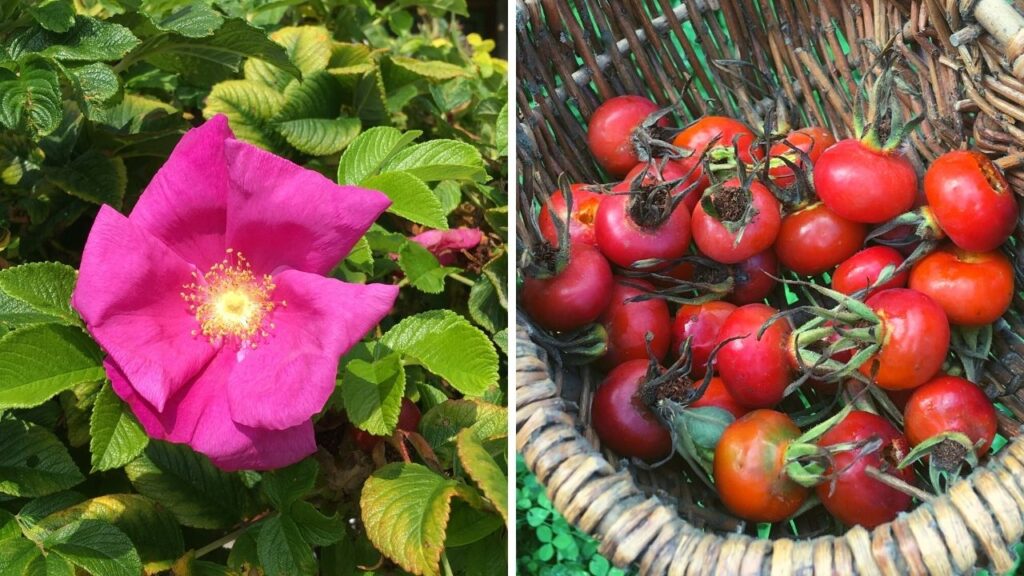The Best Way To Eat Rosehips
If you’re not eating rosehips already, you need to start. Not only are they really good for you, but they taste amazing… like a burst of tropical fruit. They are also very common and easy to identify. So, what’s stopping you?
I really look forward to the season for rosehips, they are one of my favourite wild foods. The bright red scattering of rosehips in our hedgerows is one of the biggest indicators that winter is settling in. These vibrant fruits stand out to our eyes and that bright colour could mislead you into thinking that you should stay away from them, but the rosehip can make some delicious winter recipes to keep you going through the colder months.
I made this short video to show you the best way to eat rosehips raw, right off the branch. They make a great ‘pick-me-up’ on a country walk. There’s a couple of essential tips you need to know, so check it out…
Where & When To Find Rosehips
Rosehips grow on wild rose bushes. In the UK there are two species which you can forage from; the dog rose (Rosa canina) and the field rose (Rosa arvensis). Dog rose is found in most parts of the UK, unlike the field rose which is only found in England and Wales. Both species can be eaten so it’s not particularly important to know the difference between the two. These plants are climbers, trailing their way through hedgerows with their stems covered in thorns.
The rosehips themselves are easy to identify as oval fruits which develop behind the summer flower, turning from green to red as they ripen. In the summer the petals for both wild roses are large, being pink to white in colour with a yellow stamen. They have a beautiful fragrance, as you’d expect from a rose.
The best spots for finding rosehips is hedgerows and woodland edges, where the hips can ripen with plenty of sunshine. Scrubland and brownfield sites are also good places to look.
It’s from September that the hips begin to ripen enough to be harvested. They should only be eaten once they are fully red, don’t eat them if they’re still a bit green. There isn’t a particular firmness they are best at; they can be harvested when squishy or hard so don’t worry if you don’t get them right at the beginning of the season. What is important though is that you’re only eating the red flesh. The hairy, yellow seeds in the centre of the hip need to be removed before they can be eaten. These hairs are very fine and can lodge in your throat, being very uncomfortable to digest.
If you haven’t watched our video above already, do check it out so you can learn how to easily remove the flesh from the hairy seeds. Another method can be used back in the kitchen, whilst processing the hips back at home using a muslin cloth (see our method for rosehip syrup below) but if you’re out in the field after a quick hot of that tropical taste then here’s what you need to do:
- Look for the softer squishy ones with a wrinkled skin. These are found more so at the back end of autumn.
- To remove the hip cleanly, and avoid being spiked, twist is away from you and toward the stalk. This will usually give a clean break.
- Hold the rosehip between both thumbs and index fingers equally, with the stalk side facing you.
- Squeeze the hip with even pressure. A ‘red worm’ of pulp should rise from the hole.
- Eat the tasty red flesh, discard the squeezed hip.

Above Left: Rosehips looking perfectly ripe on the branch. Above Right: These hips are softer and more wrinkled. Perfect for the squeezing method as explained in the video.
How To Make Rosehip Syrup
A more traditional use for them would be rosehip syrup, which was a common sight in the household during the second world war. Due to the UK’s inability to import fruit from other countries, the public were recommended to collect and make their own rosehip syrup to prevent scurvy; two tablespoons of rosehip syrup would more than provide you with your daily dose of vitamin C. As well as being very good for you, the syrup is deliciously sweet and goes really well drizzled on top of hot sponges, pancakes, and other desserts or you could try adding a little to some lemonade to make a cordial. Below is a recipe for rosehip syrup so you can make your own.
To make a litre of syrup you need:
- 1 kilogram of rosehips
- 3 litres of water
- 450g of sugar (or honey)
Method:
- Remove any leaves and the green ends of the rosehips, then chop them by hand or in a food processor and add to a saucepan with the water.
- Bring to the boil and simmer for 20-30 minutes before straining with a muslin into a clean bowl. Once the juice has been strained, re-strain in a clean muslin cloth. This ensures that all the hairs inside that cause irritation have been removed.
- In a new saucepan add the sugar and simmer together until it has dissolved and the liquid has thickened.
- Transfer to a sterilised jar and keep in a cool place.
As well as being delicious on pancakes and packed with vitamin C, rosehips also have a fantastic range of health benefits. Amazingly, rosehips contain 2000mg per 100g, compared with the equivalent weight of orange with just 50mg! This little fruit can boost heart health by lowering cholesterol and blood pressure. Rosehips also have anti-inflammatory properties and there is some evidence it can reduce pain and stiffness in joints with osteoarthritis, possibly due to the high level of antioxidants they contain. Cold pressed rosehip oil can also help protect against ultraviolet light, pollution, and cigarette smoke as well as increasing skin elasticity. They also contain high levels of fibre, vitamin A, calcium, and potassium.
I’ve also used them to make a cup of rosehip tea. To try this yourself; halve ten hips and scrape out the seeds and hairs. Cover the hips in boiling water and leave to infuse for a few minutes. You could add a little honey or sugar to sweeten your tea, but rosehips contain their own natural sweetness, so adding sugar is not essential, just see how you like it.
You could always try slicing and drying the hips to make a longer-lasting tea ingredient. If you don’t have a dehydrator, put the halved hips on a parchment covered baking tray and cook on a very low heat with the door slightly open for a few hours to remove the moisture. Rosehips can also be used to make a sweet jam to go on toast or on plain yoghurt. We added halved rosehips to a hedgerow crumble for a burst of colour and flavour amongst the apples and blackberries.

Above Left: Rosehip syrup. Above Right: Fruit leather with rosehips, crab apple and hawthorn.
Can I Eat My Garden Roses?
This is a fair question, so let’s look into it. As far as I have researched, all roses are edible. You might well be familiar with the Japanese Rose (Rosa rugosa) which is a common sight in suburban areas and retail centre car parks. The rosehips on this plant are much larger, being more rounded. They also ripen earlier than our native roses. The summer petals on this plant are a beautiful cerise pink colour. Both the petals and hips are edible, as with our wild roses. However I have found that these hips, being larger, are more susceptible to harbouring maggots, especially when they start to soften. So, I would recommend halving them to have a good look inside before using them for any cooking.
Something else you need to be aware of with foraging garden roses, including the Japanese Rose, is that they may have been sprayed with pesticide or plant food, not something you want to add to your diet. So, unless you know the garden or gardener well, it’s best to avoid Mr Jones’ prize roses from across the road. With any foraging it’s important to take a wider view and think about where you’re picking from and what forces those plants are subjected to. As always; if in doubt, leave it out.

Above: Japanese Rose (Rosa rugosa) with striking pink flowers in summer and hips as large as cherry tomatoes.
Discover More Wild Foods
If this has got your appetite for wild foods whetted then you should check out our online foraging course. It’s called Your Wild Food Year, and it covers over 80 wild food species over 12 months. You can find out more about the course here or sign up to a free taster.
Along with my partner, James, I host foraging and wild food walks and courses in North-East Wales at two beautiful National Trust estate grounds. Coming on a course is a great way to learn a variety of commonly growing plants and fungi we can use in our own cooking and also for hedgerow medicine. If you’d like to see what courses we have coming up, then head to our Events page.
I hope this blog has inspired you to try foraging rosehips yourself.
Lea

